Best Equipment Rental Software Comparison
The table and profiles detail each equipment rental software’s ideal use case, strengths, and weaknesses. Equipment rental firms should consider their industry focus (e.g. tours vs. events vs. construction rentals) and required features (e-commerce integration, mobile support, enterprise vs. SMB scale) when choosing among these solutions. Each product’s distinctive features and pricing model are highlighted to aid comparison.
| Software | Best For / Industries | Pricing (starting) |
|---|---|---|
| Rentrax | Equipment rental businesses and tour providers (bike, skis, tours, etc.) | From ~$10/month (entry) up to $119–$479/mo for higher tiers |
| FareHarbor | Tour, activity and attraction operators (tours, rentals, museums, aquariums) | No subscription; only per-booking fees (≈1.9% + $0.30 per transaction) |
| PeekPro | Experiences and attractions (tours, rentals, recreational activities) | Contact vendor (custom pricing) |
| Checkfront | Tour, activity, and rental businesses (including accommodations/tours) | ≈$225/month (Growth plan) + 3% per-booking fee |
| Booqable | Small-to-midsize rental shops (AV, party, equipment rentals, startups) | From $27/month (Small plan for 1 user) |
| Point of Rental | Rental companies of all sizes (tool, heavy equipment, events) | Contact vendor (pricing on request) |
| Rentman | AV/event production and equipment rental firms (broadcast, parties) | From $9/month (Basic) |
| EZRentOut | Tool, machinery, AV, medical or vehicle rental businesses | From $59/month (Essential plan) |
| Texada (SRM) | Small to large rental enterprises (construction, industrial equipment) | Contact vendor (pricing on request) |
| Goodshuffle Pro | Event and party rental companies (wedding, tents, décor, A/V, etc.) | From $99/month (Basic plan) |
| Quipli | Independent rental companies (equipment/tools, small rental shops) | From $27/month (Starter plan) |

1. Rentrax
Best For: Equipment and tour rental businesses of various sizes (bike/ski shops, tour operators, outfitters)

Rentrax is an all-in-one, cloud-based rental and tour management software designed to help rental shops and guided tour companies manage inventory, bookings, rates, and returns. It streamlines the entire rental lifecycle with online booking, inventory tracking, and dynamic pricing.
Pros:
- Intuitive interface
- Centralized online booking and customer management
- Strong support
- Automates waivers and seasonal pricing
- Integration with payment providers such as Square and Stripe.
Users praise time savings (no more pen/paper) and flexible pricing features.
Cons:
- Inventory module can be confusing to set up
- Some features (like multi-language support or in-depth customization) may be limited
Some customers note a learning curve for complex operations and occasional missing advanced niche features.
Pricing:
Usage-based; reportedly start very low (as little as $10/month). Also Free trial is available.
Client Feedback:
Users love Rentrax for improving efficiency and revenue: one reviewer says they “got rid of pen & paper” and saw revenue increase after adopting Rentrax.
Customers highlight responsive support and the ability to customize rates by season or time. Also, its the best bike rental software since it was made by a bike rental owner.
Top 5 Features:
- Online 24/7 booking system (web and mobile)
- Real-time inventory management (track availability and condition)
- Dynamic/seasonal pricing engine
- Digital waiver and contract collection
- Multi-location and resource management from one dashboard.

2. FareHarbor
Best For: Tour, activity, attraction and equipment rental operators.
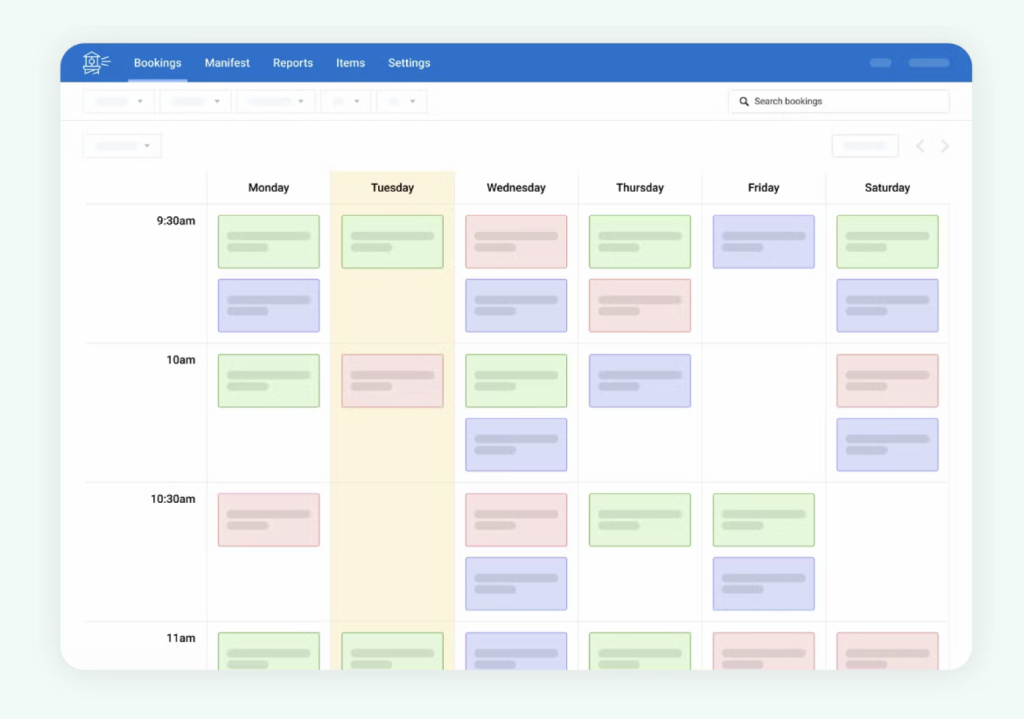
FareHarbor is an all-in-one bookings and operations platform tailored for tours and attractions. It provides an online reservation system, real-time availability, and backend tools (inventory, scheduling, analytics) suited to destinations from small tour guides up to large entertainment venues.
Pros:
- Very user-friendly booking interface with robust backend (inventory, schedules, reporting)
- Seamlessly integrates with affiliate channels (e.g. TripAdvisor)
- Offers 24/7 support
- Users note it can handle almost all operations from one dashboard.
Cons:
- Commission-based pricing can be expensive at scale (e.g. 6% booking fee)
- Initial setup/training may be lengthy; some advanced reporting needs improvement
- A few customers felt the UI lacked some depth and that passing booking fees to customers isn’t straightforward.
Pricing:
No fixed monthly fee – FareHarbor is “free” to install, charging only per-transaction fees (roughly 1.9% + $0.30 per credit card payment, often reflected as ~6% total to customer).
Client Feedback:
Reviewers rave about ease of use: e.g. one says FareHarbor’s “User-Friendly Interface” lets them “complete everything in the back end” (inventory, taxes, future bookings) with minimal effort. Another notes “great software” but mentions that “the cost…is quite a setback”. Customers emphasize the strong support team, though some question high fees (one specifically cited a 6% fee as “very high”).
Top 5 Features:
- Robust online booking engine (including website widgets)
- Comprehensive inventory and resource scheduling management
- Integrated payment processing and checkouts; advanced reporting and analytics
- 24/7 support
- White-glove onboarding
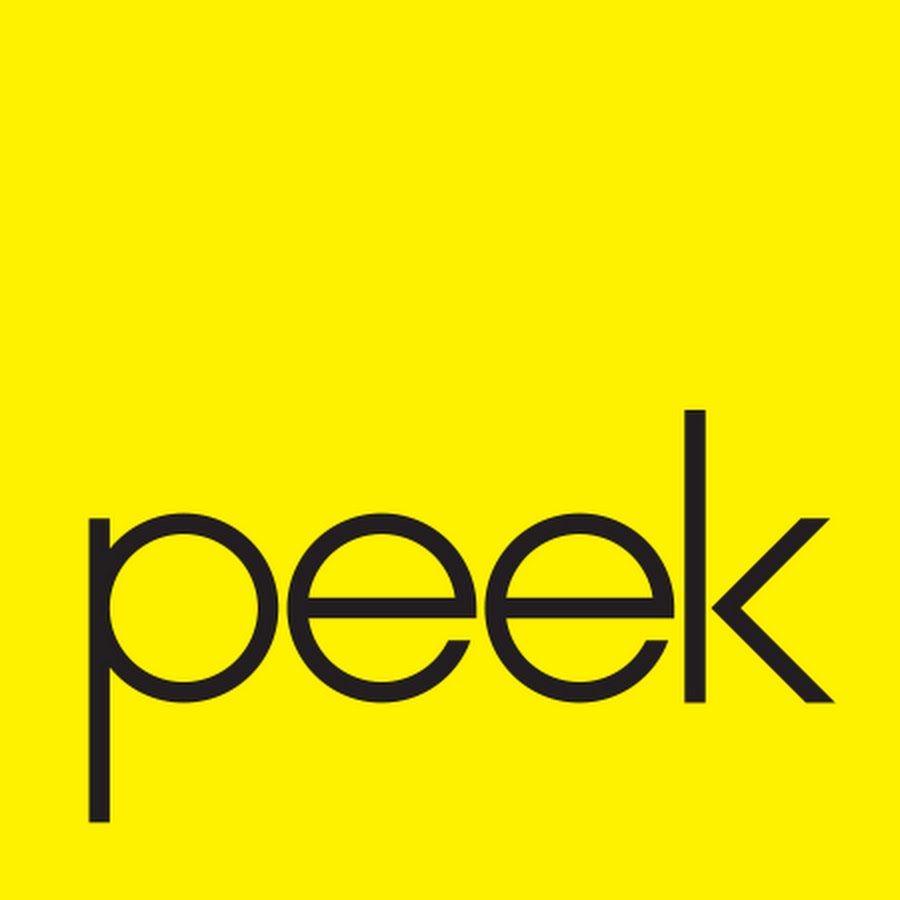
3. PeekPro
Best For: Experience and attraction providers (tours, activities, rental experiences).
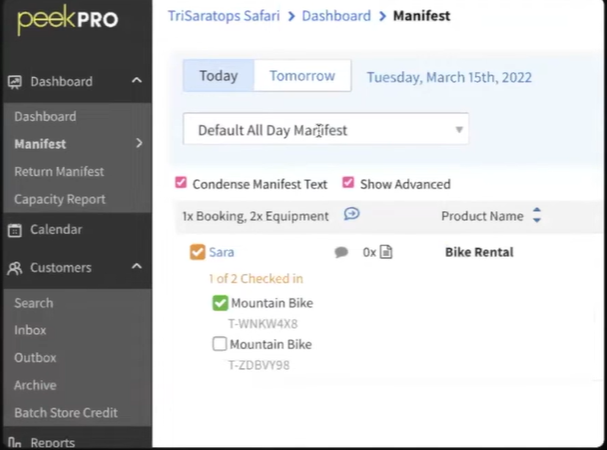
Peek Pro is a cloud-based operating system originally designed for tours and attractions. It offers a mobile-friendly booking portal and backend system for managing reservations, availability, digital waivers, and customer communications. Its automation and mobile tools aim to make event and tour management fast and easy.
Pros:
- Very user-friendly with quick setup.
- Customers report Peek Pro streamlined reservation management and had the best “crew planner” they’d seen.
- Support during onboarding is highly praised (“top notch”)
- Mobile responsiveness allows team members to work from tablets or phones
Cons:
- Lacks public pricing transparency (must contact vendor)
- Some advanced inventory features (e.g. booking by serial number, detailed stock intake) are limited
- UI can be cluttered or “overengineered” for certain workflows, requiring training
- A few users note missing capabilities in equipment tracking modules and lack of native purchasing/PO tools
Pricing:
No published rates; interested companies must request a quote. (Known plans reportedly start very low, but custom quotes are provided.)
Client Feedback:
Users commend Peek’s frequent updates and unlimited user access. One events manager reports “PeekPro is easy to navigate” and praise its mobile-friendly setup. PeekPro consistently receives positive remarks for its modern interface and streamlined workflows. (No major negative reviews are cited publicly, aside from suggestions for enhancements like more integrations.)
Top 5 Features:
- Real-time bookings and availability updates (cloud portal)
- Digital waivers and automated email/sms reminders
- Resource (staff, equipment) scheduling and drag-and-drop calendar
- Integrated payments and invoicing
- Customer (CRM) portal
- Data management (with approvals)

4. Checkfront
Best For: Small to midsize tour and rental businesses that need online booking and OTA integration.
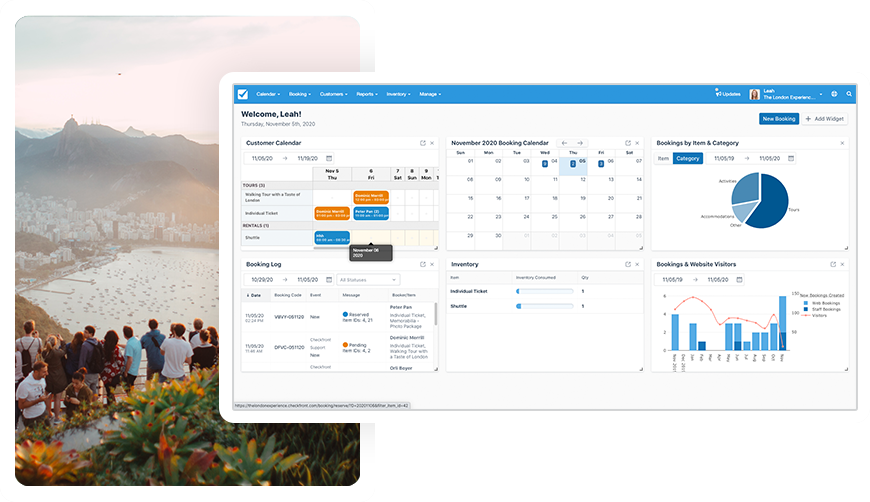
Checkfront is a cloud-based booking and rental management solution. It provides an online booking calendar, inventory tracking, and POS functionality, plus built-in payment processing. It excels in connecting with OTAs (Booking.com, Expedia, TripAdvisor) and is often used by tour operators, rental shops, and vacation rental managers.
Pros:
- Simplifies online reservations with a clean, modern interface
- Users highlight its ease of use, helpful customer support, and broad integrations (OTAs and social platforms)
- The system covers inventory, pricing, coupons, and has flexible rental pricing (daily, weekly) and bundling options.
Cons:
- Some users report missing features (e.g. limited guest form fields) and occasional bugs in the UI/widgets.
- More advanced bookings (partial day rentals) can be tricky.
- Others note that support outside North America may be limited.
- The OTA integrations can lag behind newer players.
- A few find the reporting tools lacking and the initial setup complex.
Pricing:
Subscription-based. Checkfront plans start around $225/month (Growth plan includes unlimited bookings), plus a 3% fee on each online transaction. No setup fees. (Free trials available.)
Client Feedback:
Reviewers appreciate Checkfront’s inventory and storefront. One says, “It literally has every feature you can possibly think to run a rental business… it’s kind of an all-in-one deal”. Others cite the intuitive booking flow: “clean design, smooth booking flow”. Concerns include some clunky interfaces (loading bugs) and less-robust customer support hours internationally.
Top 5 Features:
- Online booking/reservation calendars (desktop and mobile) with real-time availability
- Channel manager to sync inventory with OTAs
- Integrated payment gateway and POS
- Powerful rental pricing (multi-day, packages, coupons)
- Custom documents (invoices/contracts) and CRM (customer management).

5. Booqable
Best For: Small to medium equipment rental businesses seeking simple inventory and order management.
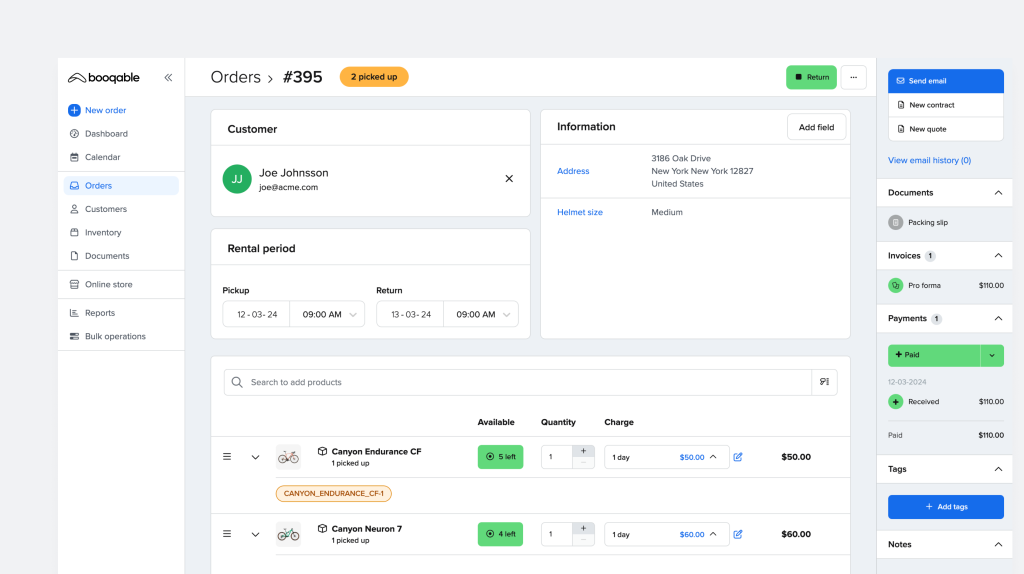
Booqable is an easy-to-use, cloud-based rental software focused on inventory and order management. It enables businesses to create an online rental store, schedule orders, and track equipment. Its clean interface and streamlined workflow make it popular among solo operators and growing rental firms.
Pros:
- Highly intuitive UI – new users get up to speed quickly.
- Customers praise its “seamless booking process and intuitive interface”.
- The platform is noted for streamlining day-to-day tasks, saving time, and reducing booking errors.
- Key strengths include flexibility (bundling items) and strong customer support.
- Many highlight the integrated booking tool that plugs into their website and manages orders easily.
Cons:
- Advanced customizations are limited.
- Some report a steep learning curve on certain features (price rules, seasonal rates).
- The entry-level inventory calendar is basic (e.g., lack of multi-warehouse support).
- A few say the order entry and onboarding could be smoother (e.g. fewer clicks to log a rental).
- Payment processing options are tied to Stripe.
Pricing:
Tiered monthly plans (flat rate). Starting at $27/mo for one user, up to $149/mo for larger teams. All plans include unlimited products/orders. (No per-booking fees.)
Client Feedback:
Users consistently call Booqable “easy to use” and note it gives their business “structure and flexibility”. One reviewer says the interface is so straightforward that “even users without a technical background” find it simple, and the low subscription price was “unbeatable”. Complaints focus on adding fees (e.g. surcharges on rentals) and multi-location limitations.
Top 5 Features:
- Real-time inventory and availability tracking
- Order scheduling calendar to avoid conflicts
- Online booking website builder with templates
- Quote/invoice generation with digital signature and contract templates
- Integrated payments (Stripe) and security deposit management
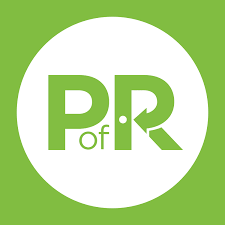
6. Point of Rental
Best For: Rental operations of all sizes, general tool rental businesses that need comprehensive asset management.
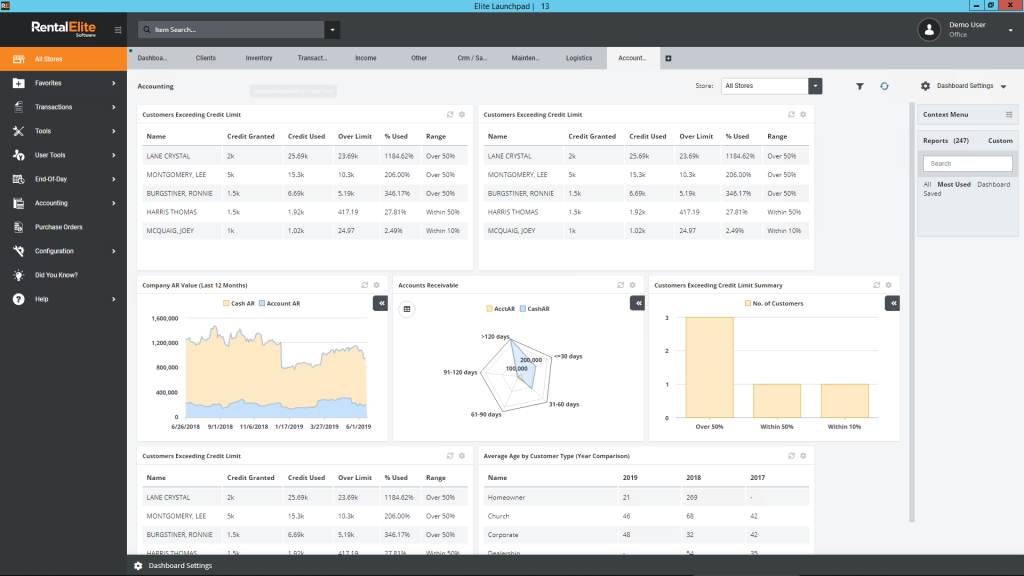
Point of Rental (POR) is a full-featured rental management suite (with Essentials and Elite editions). It handles quoting, inventory, delivery scheduling, and maintenance. It’s known for powerful capabilities in billing (including recurring contracts), maintenance tracking, and robust workflow automation.
Pros:
- Very mature product with broad functionality.
- Users praise its equipment/consumables tracking and custom packaging of inventory.
- Many comment on reliable 24/7 support and continuous updates.
- POR excels in complex rental environments (multi-warehouse, serialized assets) and offers deep configurability.
Cons:
- Complexity and cost.
- The interface can feel dated or over-engineered;
- There’s a steep learning curve and heavy training is often needed.
- Many features require additional paid modules (e.g. dispatch, maintenance).
- Users note occasional stability bugs (crashes)
- Limited customizability in the online interface.
Pricing:
Custom/quoted pricing. (Historically offered perpetual licenses; now moving to cloud subscription model.) Interested customers must contact POR for pricing.
Client Feedback:
Customers call POR a “gamechanger” for integrating disparate systems. One review raved about “dynamic packages” for tent rentals and excellent support over a decade. Users often cite POR’s ability to “run 80% of our business” entirely within the system, although some find it complex.
Top 5 Features:
- Continuation/contract billing (daily or monthly) with automated invoicing;
- Preventive maintenance scheduling and equipment service orders;
- Multi-location inventory and serialized equipment tracking;
- Integrated CRM and invoicing, including digital contracts;
- Mobile field app (barcode scanning of assets) with delivery/dispatch tracking
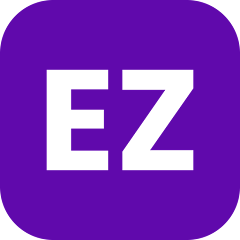
7. EZRentOut (EZO)
Best For: Equipment rental businesses of all sizes seeking an online booking solution
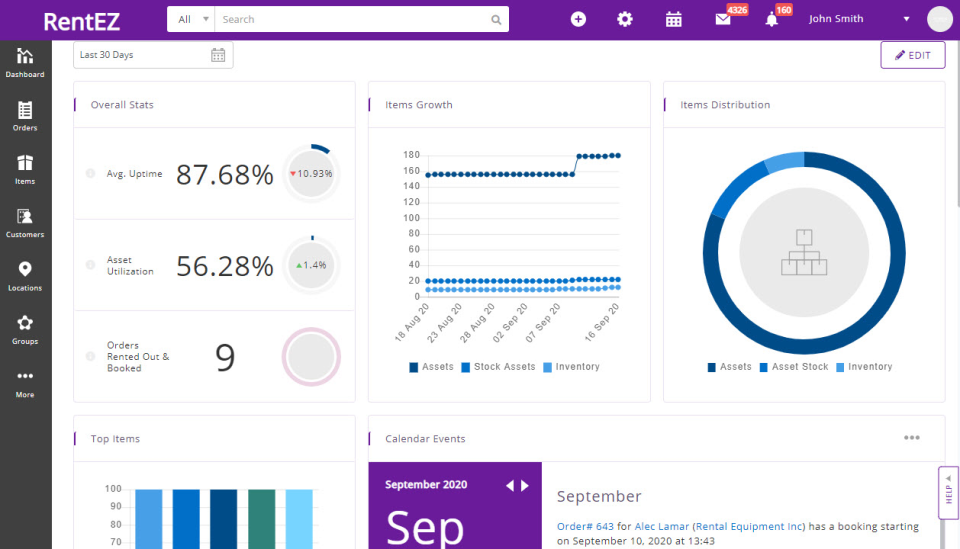
EZRentOut is a cloud rental platform aimed at making rental operations efficient. It offers an online store, inventory tracking, order management, and maintenance scheduling. The system automates the rental workflow (quotes to check-out/check-in) and is notable for combining reservation software with built-in e-commerce capabilities.
Pros:
- Very user-friendly and flexible.
- Users describe EZO as making them feel like a “CEO of the rental world” with simple booking and inventory management.
- Its clean interface and feature-rich modules (bundling, promos, barcode scanning) are frequently praised.
- Support is generally rated excellent (many reviews highlight fast, helpful service).
- It integrates easily with websites and payment gateways.
Cons:
- The abundance of features means a learning curve.
- Some find configuration tedious (lots of settings).
- A few request smoother customization and better integration for specific processes (e.g. parts invoicing, service management).
- Inventory calendar views and certain UI elements have been noted as slow or non-intuitive by some users.
Pricing:
Three flat-rate plans. Starting at $59/month for the Essential plan (one location, core features), up to $499/month for Premium (multilocation, full suite).
Client Feedback:
Users consistently cite EZRentOut’s ease of use and integration. One reviewer says it offers “almost every feature…to run a rental business” in one system. Another notes EZRentOut saved them “labor costs” by tying sales and operations together. Customer support receives high marks (“fantastic, honest, supportive”). Criticisms include wanting more robust service/parts modules and occasional interface tweaks.
Top 5 Features:
- E-commerce booking portal (embedded online store)
- Inventory & order management with real-time availability
- Automated check-in/check-out (barcode/RFID scanning)
- Integrated billing (digital contracts, payment processing) and customer portal
- Preventive maintenance scheduling and asset tracking.

8. Texada
Best For: Rental companies of any size that need full asset lifecycle management.
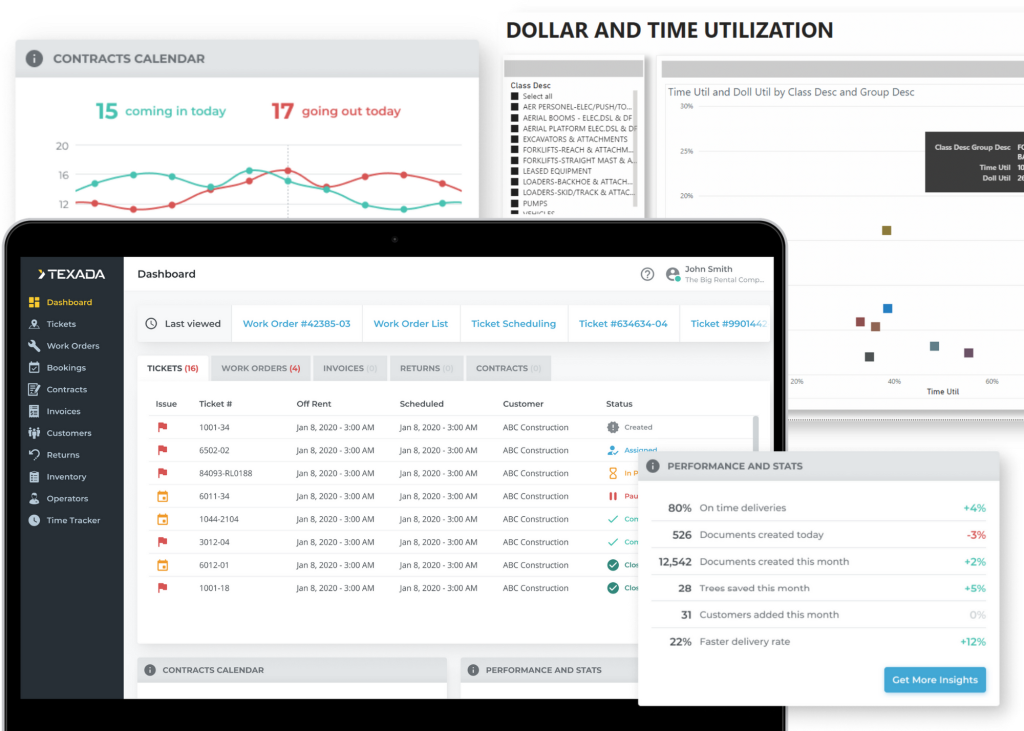
Texada SRM is a comprehensive rental management suite tailored for equipment rental businesses. It manages both rented and owned equipment, covering the entire asset lifecycle (acquisition, maintenance, disposal). It includes logistics (delivery/pickup routing), barcode scanning, work orders, and integrated accounting. SRM is often used by rentals that require tight financial control and reporting.
Pros:
- Solid, “stable” platform with a broad feature set.
- Users find it “easy to use” and appreciate the extensive data access.
- The staff and support are often described as personable and caring.
- Texada’s built-in modules for AP/AR and general ledger mean customers don’t need separate accounting software.
- A sandbox (“play area”) for testing setups is also valued.
Cons:
- Customization and flexibility are limited.
- Certain setups (new tax tables, custom workflows) require vendor support.
- The reporting interface is considered weak by some – users wish for more ad-hoc report options and field selection.
- Overall it can feel rigid and there’s little self-service configurability.
- A few comment that initial training is necessary to use all features.
Pricing:
Custom pricing (quote). Texada does not list public; interested businesses must contact sales.
Client Feedback:
Customers note Texada’s stability and support culture (“Texada cares”). Equipment and tool rental software (with consumables) is cited as a pro. Drawbacks mentioned include the above custom setup issues and report limitations. Overall, experienced rental firms see it as a reliable backbone for inventory/accounting, with support that is “very stable” and “easy to train new users”.
Top 5 Features:
- Full asset lifecycle tracking (purchase, maintenance, disposal)
- Cycle/rental billing and contract management;
- Integrated routing (delivery/pickup scheduling) and barcode scanning
- Work order and preventive maintenance module
- Built-in accounting (AP/AR, GL) and detailed reporting (customers, commissions, utilization).
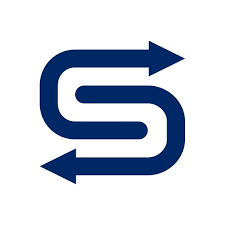
9. Goodshuffle Pro
Best For: Event and party rental companies that want an easy, modern management system.
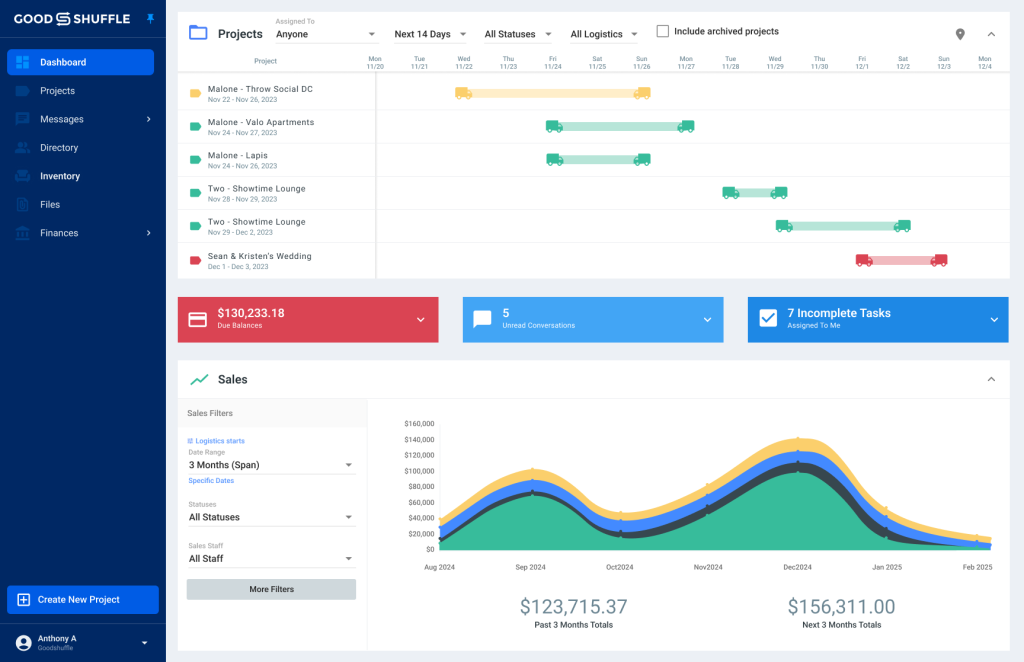
Goodshuffle Pro is an event-focused rental software. It handles the full event lifecycle: website booking, inventory control, quotes/contracts, dispatch logistics, and billing. Designed for the event industry, it offers features like inventory management, route planning, and integrated client communications in a user-friendly package.
Pros:
- Clean, modern interface with excellent customer service.
- Users highlight the ease of use from setup onward and the mobile-friendly design.
- The platform tightly integrates inventory with quoting; one reviewer says it “ties together sales and operations in one program”.
- Many love the built-in tools (digital contracts, templates) and responsive support staff.
Cons:
- Can be missing advanced features some companies want (e.g. very granular email templates or a dedicated mobile app).
- Some reviewers mention the inventory entry process as slow, and wish for in-field app capabilities.
- On a few occasions, users have complained about forced logins for customers or communication issues with the vendor, though such reports are less common than praise.
Pricing:
Goodshuffle’s Basic plan is $99/month (unlimited users, core features). (Higher tiers available for larger businesses; 30-day free trial offered.)
Client Feedback:
Clients rave about how it improves efficiency. One says Goodshuffle “drastically cuts labor costs” by combining all functions in an easy package. Customers continually praise the customer service (“top notch”) and the clean look. Feature requests often center on adding a field-sales app and more automated notifications.
Top 5 Features:
- Integrated event planning (from website booking to delivery)
- Inventory management with drag-and-drop dispatch routing
- Online quotes/contracts with e-signature and payment processing
- Customer/CRM tools (client accounts and communications)
- Financial dashboard (accounts receivable, billing, analytics) and website integration

10. Quipli
Best For: Small/independent equipment rental companies (tools, construction equipment, small machinery).
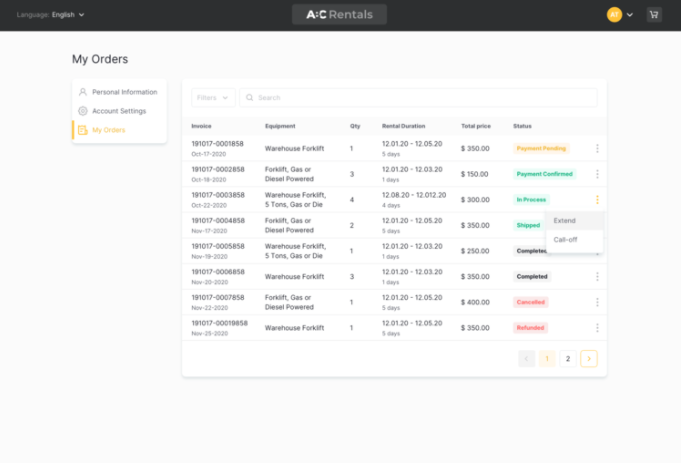
Quipli is a cloud rental platform built for independent rental businesses. It provides an SEO-optimized e-commerce website along with traditional rental management features. Quipli’s goal is to let customers browse and book equipment online easily while the company manages inventory and orders in the backend. It also supports features like digital signatures and proof-of-insurance for compliance.
Pros:
- Best-in-class customer service and rapid development. Users universally praise the Quipli team and support as “in the industry”.
- The system is designed for ease: reviewers mention “easy to use,” “fast pricing,” and an intuitive workflow.
- Unique to Quipli is its combination of rental software plus built-in e-commerce (SEO-friendly) site – one user notes it’s “one program for both rental management and customer e-commerce website”.
Cons:
- Newer product with some missing features.
- Some customers note gaps in service/parts invoicing and want improvements on the service side.
- A few mention the inventory calendar UI could be faster or friendlier.
- Stripe is the only payment gateway, which some find expensive.
- New users face a learning curve given its flexibility, though excellent support eases this.
- Currently support is email-only, and some would like phone support in future.
Pricing:
Starting at $27/month (Starter plan for one user). Higher tiers offer more users/features (e.g. $39, $59 plans). (Annual billing discounts available.)
Client Feedback:
Quipli reviews are overwhelmingly positive (most 5/5). Customers repeatedly laud the “fantastic” support and the platform’s honesty about features. They appreciate the combo of storefront and rental software – for example one says it “drastically cuts labor costs” by uniting sales and operations. Criticisms are mostly “bugs that are not crippling” and feature requests for continued improvements.
Top 5 Features:
- SEO-optimized e-commerce website (built-in online booking portal)
- Real-time inventory and reservation management (prevent double-bookings)
- Integrated checkout and payment processing with PCI compliance
- Digital contracts/waivers and online customer accounts (with proof-of-insurance upload)
- Service & repair module for managing maintenance and rental contracts.
Choosing the Right Equipment Rental Software for Your Business
Choosing the right equipment rental software is a critical decision for businesses in the rental industry. With so many options available, selecting the most suitable software can be overwhelming. To make an informed decision, businesses must consider several factors.
Business Size and Industry Requirements
The first factor to consider is the size of the business and its industry requirements. Some software solutions are designed for small businesses, while others are more suitable for larger operations. It is essential to select software that can handle the business’s current size and scale with its growth. Additionally, different industries have specific requirements, and the software must cater to those needs.
Budget
Budget is another crucial factor to consider when selecting equipment rental software. The cost of software can vary significantly, and businesses must decide how much they are willing to invest. While it may be tempting to select a cheaper option, it may not provide all the necessary features required for the business. It is essential to weigh the costs of the software against its benefits and long-term value to the business.
Scalability
Scalability is also a vital factor to consider when selecting equipment rental software. As the business grows, the software must be able to accommodate the increasing demands. The software should have the option to add new features, users, and locations as the business expands.
Integrations
The software’s compatibility with existing systems is another factor worth considering. If the business has an existing Customer Relationship Management (CRM) system or financial software, it is essential to select rental software that can integrate with these systems. Integrating the software can streamline business operations and improve efficiency.
User-Friendly Interface
The software must have a user-friendly interface that is easy to operate and navigate. Complicated software can lead to confusion, errors, and reduced efficiency. Software that is intuitive and simple to use can improve employee productivity, reduce training time, and enhance customer satisfaction.
By considering these factors, businesses can evaluate and select the most suitable equipment rental software for their needs. Selecting the right software can streamline business operations, improve efficiency, and enhance customer satisfaction.
Frequently Asked Questions
What makes equipment rental management software essential for business operations?
Equipment rental management software streamlines operations by enabling online ordering, tracking deliveries, managing inventory, and handling e-commerce platforms. It improves scheduling, offers real-time booking displays, and integrates online booking systems which facilitate customer engagement and operational efficiency.
Which features should I look for in top rental software?
Look for features such as scalability, automation, user-friendly interfaces, powerful SEO tools, integrated payment systems, real-time inventory management, and customer relationship management capabilities. These features contribute to increased productivity and profitability.
How do software reviews impact the decision-making process for choosing rental software?
Software reviews provide insights into user experiences, showcasing the practical benefits and any limitations of the software. They offer real-world perspectives on ease of use, performance, and how the software meets business requirements, aiding other businesses in making informed decisions.
What are some top equipment rental software options currently available?
Some leading equipment rental software options include Rentrax, Goodshuffle, Checkfront, EZRentOut and Point of Rental. Each offers unique features tailored to specific rental industry needs like event rentals, construction equipment, and more.
Can equipment rental software positively affect a business’s return on investment (ROI)?
Yes, equipment rental software such as Rentrax can significantly improve ROI by reducing operational costs through automation of rental business functions, minimizing manual labor, and providing features like automated billing and inventory tracking. This leads to savings in onboarding, training expenses, and enhances overall profitability.
What are the customization capabilities of equipment rental software?
Leading equipment rental softwares such as Rentrax offer extensive customization options, including tailored reporting, automated marketing, and integration with third-party apps. Businesses can adapt these systems to suit their particular operational processes and customer communication needs.
How important is security in rental management software?
Security is paramount in rental management software. Trusted systems offer strong encryption, regular security audits, and robust privacy policies to protect sensitive data. They must also be reliable, offering consistent support and trouble-shooting to ensure continuous business operations.














































































